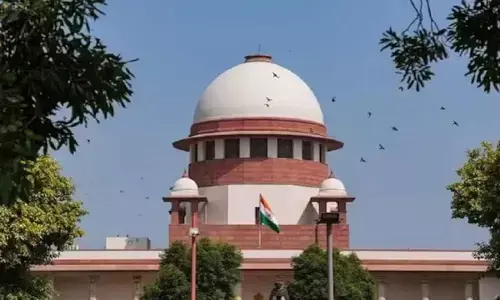Cinemas reopen: Tougher times ahead

Representational image
The appeals and pleas by the exhibitors, especially the multiplex managements, to the respective authorities to permit the resumption of the screenings at the cinemas is getting a positive response. Now, all major circuits have permitted conditional reopening.
The appeals and pleas by the exhibitors, especially the multiplex managements, to the respective authorities to permit the resumption of the screenings at the cinemas is getting a positive response. Now, all major circuits have permitted conditional reopening. One would not have expected the multiplex managements to pursue the matter considering the experience they had after the first pandemic wave closedown.
During that phase of reopening of the cinema screens, there were too many conditions laid down for the managements of cinema chains to follow that it made running of cinemas literally unviable. What with selling only 50 per cent of the capacity, cleaning and sanitizing each seat of the cinema halls between two screenings as well as checking on each viewer.
Not that there were many viewers to check on. But the overheads and the maintenance as well as the power bills would need to be paid. The managements which called the shots with filmmakers on everything to do with bookings, time slots etc granted to each new release, now not only ended up accommodating small films but did so on the terms dictated by the filmmaker! It was strange and quite contrary to how the multiplexes, used to calling the shots so far, had to discuss terms with a small film like Suraj Pe Mangal Bhari -- with the makers saying that they would release the film in cinemas only on the makers' terms. This tussle made it to the media!
When a cinema screened such a small film, it would stand to incur more loss than keeping the cinema closed. During the lockdown, many people had come to terms with it and made adjustments. A lot of people had no jobs and, resultantly, liquidity. The business houses made concessions on their dues. For instance, as almost 99 per cent of multiplexes are located in rented premises, the landlords and the multiplex owners had to come to terms. The multiplexes were to pay only 20 per cent of the normal rent of their dues for rent during the lockdown. If the rent on a property worked out to Rs 60 lakh a year, for the lockdown period it would be just Rs 12 lakh. Again, that too payable in installments along with the regular monthly rent on the resumption of business.
Now, if the cinema properties are allowed to function, even if with 50-60 per cent of the capacity, varying in each state, one can safely assume that the concessions granted may not remain the same, that is 20 per cent. Also, the electricity meters will move faster and so will the overheads. These expenses were curtailed during the lockdown. After all, you can't run air-conditioned to half the capacity because the occupancy is 50 per cent.
Coming to the audience, will people flock the cinemas just because they have reopened? Looking at the recent rush of people at hill stations in Himachal and Uttarakhand would make one believe they would. People want to break free. But then, the people have been waiting for freedom from lockdowns and restrictions all along. Probably, all who made a run for the hill stations would think they were the only ones to have this idea. They were deprived of open air, change and feel normal again. A crowded hill station offered no reprieve.
When it comes to cinema and entertainment, there is no such thing as breaking free. Fortunately, for people and unfortunately for cinemas, the OTT platforms, which have been around since 2016, suddenly got recognition and a major boost and filled the void cinema closure had created. The cost comparisons were enticing, opening up a world of entertainment with multiple options to choose from!
The governments of major states have cinemas to reopen, the latest being Maharashtra. While Telangana is the only state to allow full capacity occupancy and Gujarat 60 pr cent, the rest have limited the occupancy to 50 per cent.
Presently, there seem to be no major Hindi films slated to release in cinema halls. However, there are a few Hollywood films lined up for immediate release. These include the popular franchise Conjuring 3, Fast And Furious 9 along with Suicide Squad and Mortal Kombat. But, that would provide just a few weeks' respite.
In the hurry to get back to business as usual, the cinemas are bound to screen whatever is available because the big films with face value may still be reluctant to risk a cinema release. A big film costs big money and only in the normal situation can that be recovered. It is not for nothing that even during normal times, big filmmakers prefer to release their films on special occasions like Independence Day weekend, Republic Day, Eid, Diwali, Christmas and so on. The admission rates are raised for such films on such occasions and, here, we are talking of limited occupancy.
There are also suggestions that a few top brand multiplex managements have formed a kind of understanding on changing hand of properties. Facing uncertain times and future, many property owners may wish to either liquidate the property or look for a new tenant. The multiplex owners are said to have come to an understanding among themselves that they won't touch such property. I think, in the present circumstances, the owners may prefer status quo.
The hopes of big films lying ready since the first lockdown waiting for cinematic release, may not materialize at all. In normal times, cinema release for a big film meant big initial draw besides the fact that the OTT realization a few weeks thereafter was assured. However, with cinema release, the recouping of investment would be spread over a few months besides the fact that, if the film was not appreciated, the box office collections would disappoint, fall short.
Now, there is an alternative even for assured returns on investment in a film. The OTT platforms have raised their threshold. Besides, the sanctioned projects and buying out the ready products of certain budgets, they are now talking of crores of rupees for films with a face value. And, it is all money across the table, and secured, whatever the fate of the film.
Salman Khan's Radhe was one such to premiere on OTT while the Ajay Devgn starrer, Bhuj: The Pride Of India, is next in line, due for August 13 release on Dusney+Hotstar. There is talk that Rohit Shetty's long-awaited Sooryavanshi, was also a done deal project for OTT release. But, no official announcement is forthcoming.
The film industry has seen many transitions but what is happening now is unprecedented. No one can predict the course it will take in the days to come. But, in the present circumstances, for the cinema exhibition trade, the sensible course would be to come to terms with the idea of simultaneous release with OTT.













